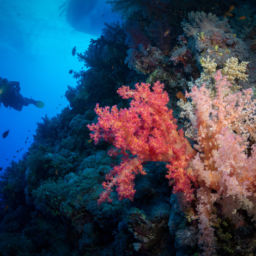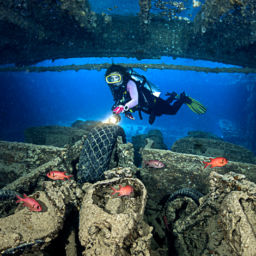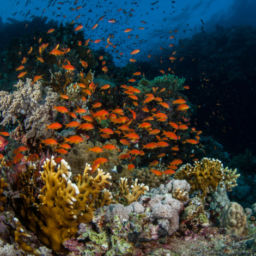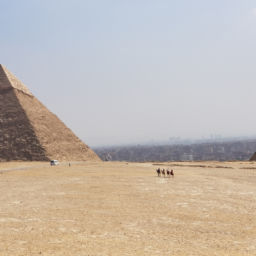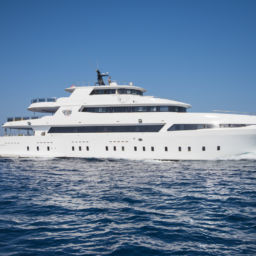I was missing a shark. Whale sharks, great white sharks, bull sharks, hammerheads—I’d been lucky to see them all. But an oceanic whitetip? Nope, and it was gnawing at me. A planned trip to Egypt in 2020 to see them fell through because, well…you know. So now, in September 2022, I’m finally in the Red Sea for one thing and one thing only…the oceanics or, as I quickly learn they’re called here, longimanus or longies, part of their scientific name, Carcharhinus longimanus. And—spoiler alert—I do see longies, but the journey to reach them will be almost as much fun as the destination.
Boat Sweet Boat
“We want you to feel at home on this trip, so please treat this like your mother’s sofa.” I’m sitting on one of three large, comfy sectionals in the lounge with dive guide Amr Ibrahim of the MV Grand Sea Explorer on my first day. After an unplanned arrival at 4:30 am that same morning thanks to severely delayed flights, I’ve slept through the boat briefing and check-out dive, and am now receiving a personalized introduction to the boat and dive procedures. Everything onboard the luxurious, 142-foot (43 m) ship is much as on other liveaboards—our general itinerary will be “dive, eat, sleep.”
There’s a bar and open-air gathering area on the second deck where we’ll spend lots of time discussing the day’s dives, and a fly deck above that, where those who’ve come looking for a tan can sunbathe. Divers will choose a station on the spacious dive deck and remain in the same spot all week, with several eager deckhands ready to assist at every turn. Each day, save the last, will feature three dives, and on this, the B-D-E itinerary, we’ll visit the big three: the Brothers, Daedalus, and Elphinstone reefs, beginning with Big Brother the next day.
As the morning wears on, I meet the rest of the guests. Though the boat can hold up to 28 divers, there are 20 onboard this week, hailing from nearly as many countries—Germany, the U.K., Finland, Switzerland, South Africa, Australia, and more, though I’m the only American. My South African dive buddy, Bruce, and I gear up for his second, my first, dive of the trip at Gotta Abu Ramada (the Aquarium) to check gear and buoyancy. Though uneventful (i.e., no longies), the lovely site lives up to its name and we spot tons of huge moray eels, lionfish, trevallies, clownfish, and a blue-spotted ray.
After the check-out dives, all dives will follow roughly the same procedure. Divers are split into groups A and B, each numbering 10. Amr and the other dive guide, Ahmed Fouad, will take turns guiding each group, with most of the diving done via RIBs, though we will jump off the back of the boat on several occasions. All three sites we’re visiting are famous for current, so the guide will back-roll into the water first, check which way it’s flowing, and signal the all-clear. On a countdown of three, we’ll all back-roll into the water too, conducting negative entries each time.
But first—dinner, which does not disappoint. As I make a return trip to the abundant buffet, my dreams of dropping those last few stubborn Covid pounds slip away. With a full tummy, I head downstairs to my cabin, hoping for a solid night’s sleep on the overnight trip to the Brothers, a journey of roughly seven hours, or 70 miles, from port in Hurghada.
The Brothers
In giddy anticipation, I’ve set my phone alarm for our first dive day at Big Brother, but I needn’t have worried—each day begins the same way. At 6 am sharp, Amr comes downstairs and sing-songs “wakey, wakey, happy divers, good morning,” to roust us out of bed. After a quick cup of coffee, Ahmed delivers the briefing at 6:30, as he will every day, for a 7 am dive. Renowned among divers, the small, barren islands of Big and Little Brother are reachable only by liveaboard, sitting around 40 miles (64 km) from shore. Both narrow, teardrop-shaped islands rise with sheer, vertical walls from the depths with nothing surrounding them but open water.
On Big Brother, a lighthouse has stood watch since 1883 to protect ships from the reef below, manned with four keepers who trade out shifts every 60 days. Unfortunately for the Numidia, which sank in 1901, and the Aida, which sank in 1957, the reef won. After two wall dives, featuring an insistent current, spectacular coral, and teeming fish life, we drop in on the Numidia for dive No. 3, and it’s by far my favorite. This huge British cargo ship was on only its second journey when it hit the reef with no loss of life, not 400 yards from the lighthouse. Now, it’s lying nearly vertical, cemented to the coral starting in around 65 feet (20 m) and extending all the way down to 246 feet (75 m).
Though we don’t penetrate the structure, the visibility is great—at least 80 feet (25 m)—and the metal surfaces are carpeted with soft coral, gleaming in the sunlight. Orange anthias swarm over the entire scene, and we all take turns posing with various parts of the now rainbow-colored metal as backdrop. On our leisurely swim back to the boat we fin over acres of coral inhabited by hunting lionfish and hordes of busy reef fish going about their lives and pass the engine block of the ill-fated Aida in about 25 feet (8 m) of water.
That evening, after another delicious dinner, we’re all in for a treat, as two whale sharks appear off the boat’s port side. They’re making lazy laps between our boat and the one anchored parallel to us about 200 feet (60 m) away, using our lights to hunt the inky ocean waters for dinner. And, as if to taunt us, a longie shows up too, slicing through the water sinuously near the back of the boat. Though we’re hopeful to see them underwater the next day at Little Brother, it’s not meant to be, and after three lovely—but sharkless—dives there, we motor on to our second stop: Daedalus reef.
Daedalus
I don’t always skip a dive, but when I do, it’s the best one of the trip. On our second dive at Daedalus, I’m feeling tired—a bit lazy if I’m honest—and we hadn’t seen much on the first dive. And, just like a newbie who hasn’t yet learned the lesson that the ocean can withhold one minute and deliver spectacularly the next, I skip the dive. And what a dive it turns out to be—at least according to my boat mates. Graced with both a manta ray sighting and school of hammerheads, everyone else is giddy when they get back on the boat. As Ahmed has said each day, “One percent luck is better than 100 percent experience.” Turns out I should have listened.
We’d arrived at Daedalus in the early morning hours, after a 10-hour, overnight boat ride. Sitting smack-dab in the middle of the Red Sea 46 miles (74 km) from shore, it’s another small, uninhabited island save for those manning another lighthouse, built here in 1863 and rebuilt in 1931. Just like the Brothers, it’s only reachable by liveaboard, and features similar underwater topography—sheer, coral-covered walls dropping off to the depths, with a 165-foot-wide (50 m) plateau starting in 80 feet (25 m) of water. This, of course, is the best place to see sharks. Which I don’t. Nonetheless, our third dive is lovely.
The current here, just as at Brothers, typically runs north to south and splits when it hits the wall. We’d planned to drop in on the Red Sea’s biggest anemone city, which clings to the wall on the western side of the island in around 30 feet (10 m), say hi to the Nemos, and turn right, keeping the reef to our left shoulder all the way back to the boat. Instead, after snapping a few pics with the obliging clownfish, our intrepid guide Ahmed turns us left, allowing us to drift with the current nearly all the way up the side of the island to its point.
Though there are plenty of other liveaboards at Daedalus and lots of bubbles in the water, we blissfully see no one on our dive, save for the turtles, napoleon wrasse, tuna, and jacks that swirl in abundance. After dinner, it’s another overnight journey of around seven hours to our final destination: Elphinstone, and our last hope to see longies in the water.
Elphinstone
Running north-south, the cigar-shaped Elphinstone reef is entirely submerged, save for a few breakers at the surface. It sits around five miles offshore, 18 miles (30 km) south of Port Ghalib and 18 miles (30 km) north of Marsa Alam, making it a popular day-boat destination, as well as a liveaboard mainstay. Just as at Brothers and Daedalus, its plunging walls are covered in coral and reef fish, but never mind that—we’re here to see sharks. We’ve got three dives to do it, and the anticipation on the boat is palpable. After Ahmed’s briefing, everyone gears up excitedly and boards the RIBs. We’ll motor up the east side of the island for the first morning’s dive, past all the other boats at mooring, and try to swim out to the plateau to look for sharks.
On the count of three, we back-roll into the water, but the current is not our friend, preventing us from reaching the plateau and instead gently insisting that we drift along the wall back to our boat. After an uneventful 40 minutes or so, we’re nearing the other moored boats and we see a crowd of divers under one in particular. Then Ahmed spots it—a juvenile longimanus, doing figure eights around the group. We hang out in the water for a bit, entranced, as we drift back to our boat. Along the way we spot two more of these unmistakable sharks, with their clear, searching eyes and bright white patches at the tips of their pectoral, dorsal, and caudal fins.
The group surfaces, giddy after seeing the longies, but the best dive is yet to come. Oceanic whitetips often hang out right underneath the boats at Elphinstone, so on our second dive, after a brief foray out to the plateau, we turn and head back to the boat to wait and see who shows up. All 20 divers from our boat are here, and we’ve been told in our longie briefing to stay together as a group in about 20 to 30 feet (6 to 10 m) of water, and to watch all directions—in front of us, behind, left, right, and especially from below. Known for their fearlessness and curiosity, longies often approach divers directly, only veering aside at the last second.
When they materialize out of the blue, we’re all pointing and shouting excitedly into our regulators—though that may just be me. Three separate sharks appear during our dive, each roughly 6 feet (2 m) long. They approach the photographer in our group, bumping off his dome port, perhaps curious about the reflection of themselves they see in the shiny apparatus. In total, we spend 52 minutes with the sharks, as they grow ever nearer and bolder in their examination of us. One comes up beneath me and takes a quick nibble on the weights dangling from a line beneath the boat, and I inch back ever so slightly.
A particularly curious shark takes an interest in one of our divers and, after it comes just a bit too close for comfort, our time with the longimanus is over. As I surface, I’m left with a feeling of both exhilaration and respect for these animals that we were all so anxious to see. In our excitement, it’s easy to forget that these are apex predators. They don’t care how many dives we’ve had, or that we just need to get the right angle for the right shot, or that we’ve traveled across the world to see them. Reverence is due, and that’s what I’m left with as we pull anchor and motor toward the last dive sites of the trip near Hurghada, where we’ll disembark the day after next.
Epilogue
And what a gift our last dives are, at an island aptly named Small Giftun. Two more drift dives are in store, both starting in around 100 feet (30 m) and gradually leveling up into a stunning, sun-dappled coral garden. We drift over an enormous stand of gorgonian fans, and the light’s rays pierce through the healthy fields of hard coral while the soft coral sways in the current. It’s an explosion of life and color, with schooling fusiliers, anthias, moray eels, and a blue-spotted stingray all swimming by to say hi. Though I don’t see a single shark on these two dives, they stand among my favorite of the entire trip. And so maybe I’ll learn my lesson this time—nature often offers treasure where you least expect it. I may have come to Egypt for one thing, but the Red Sea gave so much more.
Make it Happen
The MV Grand Sea Explorer operates in Egypt as M/Y Sea Serpent Grand and conducts both northern and southern itineraries. At 142 feet (43 m) long, the spacious ship can accommodate 22 to 28 divers in 14 state rooms, with two suites, two double cabins, and 10 twin cabins.
There are two itineraries, both departing from Hurghada, though occasionally from Port Ghalib. For ease of arrival—and luckily in case of delayed flights—the boat spends the first night in the marina at Hurghada, departing around 7 am each Friday. The North & Brothers itinerary features greatest hits like the Thistlegorm, Ras Mohamed National Park, the Brothers, and Abu Nuhas. The B-D-E itinerary is just as it’s named, covering the big three: the Brothers, Daedalus, and Elphinstone.
Although the boats operate year-round, September, October, and November make for particularly appealing diving as the air and water are a bit cooler and its prime oceanic season. High season runs from March through May.
Divers on the MV Grand Sea Explorer can expect one guide for every 8 to 10 divers, depending on how many passengers are on board. Nitrox fills are free, so it’s best to be certified far in advance. Because most of the dive sites are conducted on walls with the possibility of strong currents, the Red Sea is best suited to divers with some experience.























